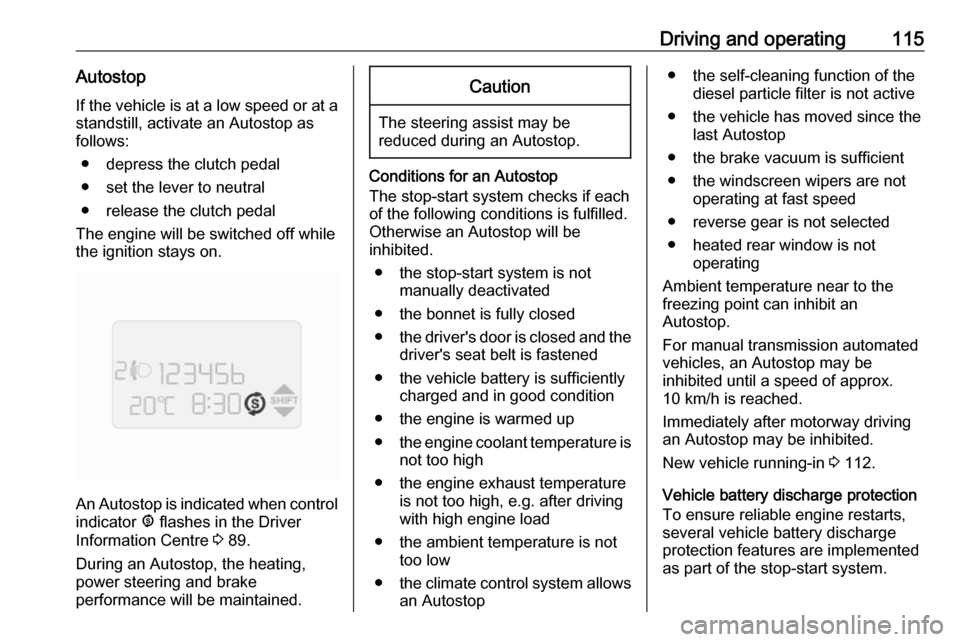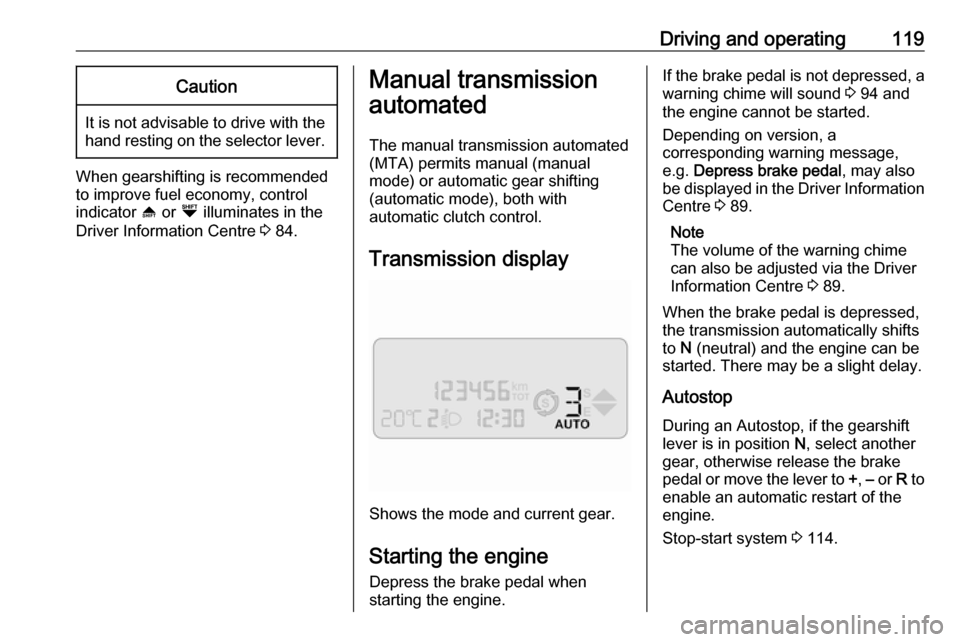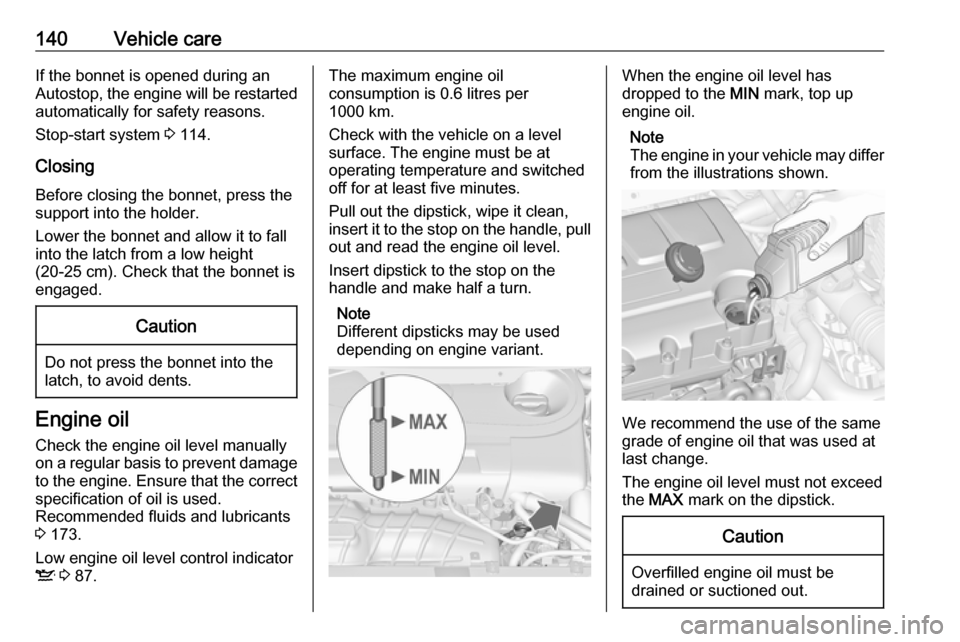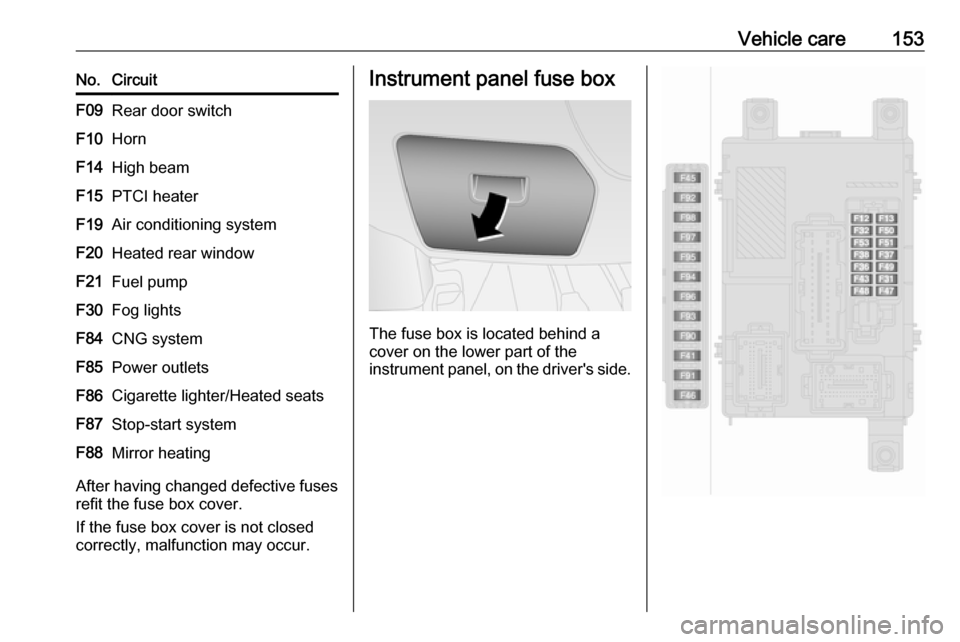stop start OPEL COMBO 2017 Manual user
[x] Cancel search | Manufacturer: OPEL, Model Year: 2017, Model line: COMBO, Model: OPEL COMBO 2017Pages: 195, PDF Size: 4.71 MB
Page 117 of 195

Driving and operating115AutostopIf the vehicle is at a low speed or at a
standstill, activate an Autostop as
follows:
● depress the clutch pedal
● set the lever to neutral
● release the clutch pedal
The engine will be switched off while
the ignition stays on.
An Autostop is indicated when control
indicator ^ flashes in the Driver
Information Centre 3 89.
During an Autostop, the heating,
power steering and brake
performance will be maintained.
Caution
The steering assist may be
reduced during an Autostop.
Conditions for an Autostop
The stop-start system checks if each
of the following conditions is fulfilled.
Otherwise an Autostop will be
inhibited.
● the stop-start system is not manually deactivated
● the bonnet is fully closed
● the driver's door is closed and the
driver's seat belt is fastened
● the vehicle battery is sufficiently charged and in good condition
● the engine is warmed up
● the engine coolant temperature is
not too high
● the engine exhaust temperature is not too high, e.g. after driving
with high engine load
● the ambient temperature is not too low
● the climate control system allows
an Autostop
● the self-cleaning function of the diesel particle filter is not active
● the vehicle has moved since the last Autostop
● the brake vacuum is sufficient ● the windscreen wipers are not operating at fast speed
● reverse gear is not selected
● heated rear window is not operating
Ambient temperature near to the
freezing point can inhibit an
Autostop.
For manual transmission automated
vehicles, an Autostop may be
inhibited until a speed of approx.
10 km/h is reached.
Immediately after motorway driving
an Autostop may be inhibited.
New vehicle running-in 3 112.
Vehicle battery discharge protection
To ensure reliable engine restarts,
several vehicle battery discharge
protection features are implemented
as part of the stop-start system.
Page 118 of 195

116Driving and operatingRestarting the engine
Manual transmission
The selector lever must be in neutral
to enable an automatic restart.
Depress the clutch pedal to restart the
engine.
Manual transmission automated
If the lever is in position N, select
another gear, otherwise release the
brake pedal or move the lever to +, –
or R to enable an automatic restart.
If an electrical accessory, e.g. a
portable CD player, is connected to
the power outlet, a brief power drop
during the restart may be noticeable.
Restarting the engine with the key When one of the following conditions
occurs during an Autostop, the
engine will need to be restarted
manually using the key.
● the driver's seat belt is unfastened and the driver's door
is opened
● three minutes have elapsed since the engine was switched offIn this event, control indicator ^
flashes in the Driver Information
Centre in conjunction with a warning
chime. Depending on version, a
corresponding message may also be
displayed in the Driver Information
Centre 3 89.
Fault
If control indicator Æ illuminates in the
instrument cluster, there is a fault in
the stop-start system 3 88.
Depending on version, 9 will
illuminate as an alternative if control
indicator Æ is not present. A
corresponding warning message,
e.g. Start&Stop unavailable , may also
be displayed in the Driver Information
Centre 3 89.
Generic warning 9 3 80.
Seek the assistance of a workshop.Parking9 Warning
● Do not park the vehicle on an
easily ignitable surface. The
high temperature of the
exhaust system could ignite the
surface.
● Always apply parking brake without pressing release
button. Apply as firmly as
possible on a downhill slope or
uphill slope. Depress brake
pedal at the same time to
reduce operating force.
● Switch off the engine.
● If the vehicle is on a level surface or uphill slope, engage
first gear before switching off
the ignition. On an uphill slope,
turn the front wheels away from
the kerb.
If the vehicle is on a downhill
slope, engage reverse gear
before switching off the ignition. Turn the front wheels towardsthe kerb.
Page 121 of 195

Driving and operating119Caution
It is not advisable to drive with thehand resting on the selector lever.
When gearshifting is recommended
to improve fuel economy, control
indicator [ or Ò illuminates in the
Driver Information Centre 3 84.
Manual transmission
automated
The manual transmission automated
(MTA) permits manual (manual
mode) or automatic gear shifting
(automatic mode), both with
automatic clutch control.
Transmission display
Shows the mode and current gear.
Starting the engine
Depress the brake pedal when
starting the engine.
If the brake pedal is not depressed, a
warning chime will sound 3 94 and
the engine cannot be started.
Depending on version, a
corresponding warning message,
e.g. Depress brake pedal , may also
be displayed in the Driver Information Centre 3 89.
Note
The volume of the warning chime
can also be adjusted via the Driver
Information Centre 3 89.
When the brake pedal is depressed,
the transmission automatically shifts
to N (neutral) and the engine can be
started. There may be a slight delay.
Autostop
During an Autostop, if the gearshift
lever is in position N, select another
gear, otherwise release the brake
pedal or move the lever to +, – or R to
enable an automatic restart of the
engine.
Stop-start system 3 114.
Page 127 of 195

Driving and operating125Hill start assistThe system helps prevent unintended
movement when driving away on
inclines.
When releasing the brake pedal after
stopping on an incline, the brakes
remain on for a further two seconds.
The brakes release automatically as
soon as the vehicle begins to
accelerate.
If control indicator Z 3 84 illuminates
while driving, there is a fault in the Hill
start assist. Depending on version, a
corresponding warning message,
e.g. Hill holder unavailable , may also
be displayed in the Driver Information
Centre 3 89. Seek the assistance of
a workshop to have the fault remedied.
The Hill start assist is not active
during an Autostop.
Stop-start system 3 114.Ride control systems
Traction Control system The Anti-Slip Regulator (ASR) is a
component of the Electronic Stability
Control (ESC).
ASR improves driving stability when
necessary, regardless of the type of
road surface or tyre grip, by
preventing the drive wheels from
spinning.
As soon as the drive wheels starts to
spin, engine output is reduced and
the wheel spinning the most is braked
individually. This considerably
improves the driving stability of the
vehicle on slippery road surfaces.
Page 142 of 195

140Vehicle careIf the bonnet is opened during anAutostop , the engine will be restarted
automatically for safety reasons.
Stop-start system 3 114.
Closing Before closing the bonnet, press the
support into the holder.
Lower the bonnet and allow it to fall
into the latch from a low height
(20-25 cm). Check that the bonnet is
engaged.Caution
Do not press the bonnet into the
latch, to avoid dents.
Engine oil
Check the engine oil level manually
on a regular basis to prevent damage
to the engine. Ensure that the correct specification of oil is used.
Recommended fluids and lubricants
3 173.
Low engine oil level control indicator
S 3 87.
The maximum engine oil
consumption is 0.6 litres per
1000 km.
Check with the vehicle on a level
surface. The engine must be at
operating temperature and switched
off for at least five minutes.
Pull out the dipstick, wipe it clean,
insert it to the stop on the handle, pull
out and read the engine oil level.
Insert dipstick to the stop on the
handle and make half a turn.
Note
Different dipsticks may be used
depending on engine variant.When the engine oil level has
dropped to the MIN mark, top up
engine oil.
Note
The engine in your vehicle may differ from the illustrations shown.
We recommend the use of the same
grade of engine oil that was used at
last change.
The engine oil level must not exceed
the MAX mark on the dipstick.
Caution
Overfilled engine oil must be
drained or suctioned out.
Page 145 of 195

Vehicle care143Only use high-performance brake
fluid approved for the vehicle.
Brake and clutch fluid 3 173.
Vehicle battery
The vehicle battery is maintenance-
free provided that the driving profile
allows sufficient charging of the
battery. Short-distance-driving and
frequent engine starts can discharge
the vehicle battery. Avoid the use of
unnecessary electrical consumers.
Batteries do not belong in household
waste. They must be disposed of at
an appropriate recycling collection
point.
Laying up the vehicle for more than
four weeks can lead to vehicle battery
discharge. Disconnect the clamp from
the negative terminal of the vehicle
battery.
Ensure the ignition is switched off
before connecting or disconnecting
the vehicle battery.
Battery discharge protection 3 104.
Replacing the vehicle battery Note
Any deviation from the instructions
given in this paragraph may lead to
a temporary deactivation of the stop-
start system.
In vehicles with stop-start system,
ensure the correct battery is used
when replacing the vehicle battery.
We recommend that you have the
vehicle battery replaced by a
workshop.
Stop-start system 3 114.
Charging the vehicle battery9 Warning
On vehicles with stop-start
system, ensure that the charging potential does not exceed 14.6
volts when using a battery
charger. Otherwise the vehicle
battery may be damaged.
Jump starting 3 166.
Warning label
Meaning of symbols: ● No sparks, naked flames or smoking.
● Always shield eyes. Explosive gases can cause blindness or
injury.
● Keep the vehicle battery out of reach of children.
Page 155 of 195

Vehicle care153No.CircuitF09Rear door switchF10HornF14High beamF15PTCI heaterF19Air conditioning systemF20Heated rear windowF21Fuel pumpF30Fog lightsF84CNG systemF85Power outletsF86Cigarette lighter/Heated seatsF87Stop-start systemF88Mirror heating
After having changed defective fuses
refit the fuse box cover.
If the fuse box cover is not closed
correctly, malfunction may occur.
Instrument panel fuse box
The fuse box is located behind a
cover on the lower part of the
instrument panel, on the driver's side.
Page 169 of 195

Vehicle care1673. Connect the black lead to thenegative terminal of the booster
battery.
4. Connect the other end of the black
lead to a vehicle grounding point,
such as the engine block or an
engine mounting bolt. Connect as far away from the discharged
vehicle battery as possible,
however at least 60 cm.
Route the leads so that they cannot
catch on rotating parts in the engine
compartment.
To start the engine: 1. Start the engine of the vehicle providing the jump.
2. After five minutes, start the other engine. Start attempts should be
made for no longer than
15 seconds at an interval of
one minute.
3. Allow both engines to idle for approx. three minutes with the
leads connected.4. Switch on electrical consumers (e.g. headlights, heated rear
window) of the vehicle receiving
the jump start.
5. Reverse above sequence exactly when removing leads.Towing
Towing the vehicle
Release the cap by carefully lifting
with a screwdriver. To prevent
damage, it is recommended to place
a cloth between the screwdriver and
the frame.
The towing eye is stowed with the vehicle tools 3 154.
Screw in the towing eye as far as it will
go until it stops in a horizontal
position.
Attach a tow rope – or better still a tow
rod – to the towing eye.
Page 193 of 195

191OObject detection systems ...........129
Odometer ..................................... 75
Oil, engine .......................... 173, 177
Operating windows from outside ..31
Outside temperature ....................71
Overhead console .......................60
Overrun cut-off ........................... 114
P Parking ................................ 19, 116
Parking assist ............................ 129
Parking brake ............................ 124
Particulate filter ........................... 117
Payload......................................... 66
Pedals......................................... 111
Performance .............................. 181
Performing work ........................139
Pollen filter ................................. 110
Power outlets ............................... 73
Power steering fluid ....................141
Power windows ............................ 31
Preheating ................................... 85
Puncture ..................................... 162
R Radio Frequency Identification (RFID) ..................................... 187
Radio info ..................................... 89
Radio remote control ...................21
Rear doors ................................... 26Rear fog light ............................... 89
Rear fog lights ........................... 100
Rear parcel shelf .......................... 62
Rear seats .................................... 40
Rear storage ................................. 61
Rear windows .............................. 33
Rear window wiper/washer .......... 70
Recommended fluids and lubricants ........................ 173, 177
Refuelling ................................... 132 Remote control ............................. 21
Removing seats ............................ 42
Reversing lights .........................100
Ride control systems ..........125, 126
Roof bars ...................................... 61
Roof load ...................................... 66
Roof rack ..................................... 65
Roof racks .................................... 66
S Safety belts ................................... 44
Seat adjustment ....................... 7, 37
Seat belt ........................................ 8
Seat belt reminder .......................81
Seat belt reminder warning chime 89
Seat belts ..................................... 44
Seat folding .................................. 38
Seat heating ................................. 40
Seat position ................................ 36
Second row seats ........................40Selector lever ............................. 120
Service ............................... 110, 172
Service display ......................77, 89
Service information ....................172
Settings menu............................... 89
Side airbag system ......................52
Sidelights ...................................... 98
Side turn signal lights ................148
Sliding door .................................. 26
Sliding side door ........................... 26
Spare wheel ............................... 163
Speed limit warning chime............ 89
Speedometer ............................... 75
Standard display ........................... 89
Starting and operating ................112
Starting off ................................... 17
Starting the engine ............112, 119
Steering ...................................... 111
Steering wheel adjustment ......9, 69
Steering wheel controls ...............69
Stop engine .................................. 80
Stop-start system.................. 88, 114
Storage ......................................... 59
Storage compartments .................59
Sun visors .................................... 34
Symbols ......................................... 4
T
Tachometer ................................. 75
Tailgate ......................................... 27